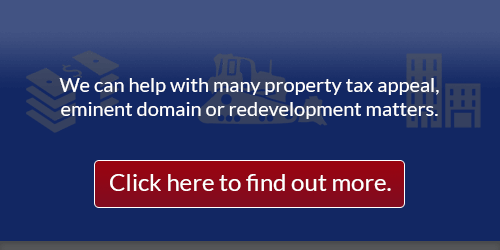How Can a Redevelopment Designation Lead to a Taking by Eminent Domain?
In short, the determination that an area is designated “in need of redevelopment” by a local government, while not a constitutional taking itself, can be a precursor to a taking if the lawful procedure is followed by the government. Unless a property owner challenges the substance of the initial redevelopment designation at the time of the government’s determination (or 45 days thereafter), the potential exists that a subsequent challenge in the context of the condemnation action will be barred as untimely. This general rule is subject to a narrow exception based on lack of notice and due process, which would extend the time for a property owner to challenge a redevelopment designation in the context of an ensuing condemnation action.
To provide an overview regarding the redevelopment scheme in New Jersey, the State Constitution authorizes redevelopment of “blighted areas” as a public purpose for which private property may be taken. N.J.S.A. Const. Art. 8, § 3, ¶ 1. Specifically, the Constitution states as follows:
(1) Blighted areas, clearance, replanning, development or redevelopment; tax exemption of improvements; use, ownership, management and control of improvements
The clearance, replanning, development or redevelopment of blighted areas shall be a public purpose and public use, for which private property may be taken or acquired. Municipal, public or private corporations may be authorized by law to undertake such clearance, replanning, development or redevelopment; and improvements made for these purposes and uses, or for any of them, may be exempted from taxation, in whole or in part, for a limited period of time during which the profits of and dividends payable by any private corporation enjoying such tax exemption shall be limited by law. The conditions of use, ownership, management and control of such improvements shall be regulated by law.
The Local Redevelopment and Housing Law (“LRHL”), N.J.S.A. 40A:12A-1 et seq., is a statutory scheme enacted in the early 1990s to consolidate and clarify the various statutes related to the exercise of redevelopment and housing powers by local governments. A determination that an area is “in need of redevelopment” pursuant to the LRHL shall be deemed to be a “blighted area” for purposes of Art. 8, § 3, ¶ 1 of the Constitution. N.J.S.A. 40A:12A-7(c). At a minimum, a redevelopment designation requires an initial investigation regarding the applicability of the statutory blight “criteria,” adequate notice to the public, and a hearing. A property owner who seeks to challenge a designation must file a lawsuit in Superior Court within 45 days of the designating resolution. The time to file a lawsuit may be extended by the Court if the government failed to provide adequate notice and due process, which includes notifying the public of the consequences of the designation (i.e., that it may lead to the taking of private property by eminent domain) and the time limits to challenge the designation (45 days).
The N.J. Supreme Court in Gallenthin v. Borough of Paulsboro, 191 N.J. 344 (2007) defined the constitutional limits of the Blighted Areas Clause:
- The Blighted Areas Clause operates as both a grant and a limit on the State’s redevelopment authority.
- The Court, and not the Legislature, is the final arbiter of what conditions constitute “blight.”
- “Although the meaning of “blight” has evolved, the term retains its essential characteristic: deterioration or stagnation that negatively affects surrounding properties.”
- The New Jersey Constitution requires a finding of “blight” in order for an area to be designated “in need of redevelopment.”
If an area is determined to be “in need of redevelopment” with the power of condemnation (i.e., a “condemnation redevelopment area”), the government can take property within the area by eminent domain, establish use regulations that effectively rezone the area, make contracts with private redevelopers for development within the area, and grant tax abatements. It is important to note that acquisitions of property are not authorized in the case of areas designated “non-condemnation redevelopment areas,” nor in areas designated “in need of rehabilitation.”
It is easy to recognize that redevelopment designations have serious consequences for property owners, especially when it includes the power of eminent domain. For over 55 years, McKirdy, Riskin, Olson & DellaPelle, P.C. has concentrated its practice in this special area of the law and has earned a reputation for persistently defending its clients’ property rights. If you are confronted with the threat of redevelopment or eminent domain, please feel free to contact us for a free consultation.







